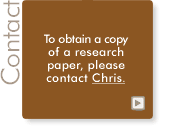
The Legacy of E-mail
With the North American average daily volume [2008] of non-spam e-mails approaching 60 per day, our stress levels and the specter of unfinished e-mail business are ever-present. There is that odd moment of anticipation punctuated by an e-mail from a much-loved business associate or the promise of landing a new piece of business, but now these have become few and far between. Instead, most corporate e-mail inboxes are clogged daily with low value, nice-to-know information that seems to be sent just because the mechanism exists to do so.
Several years have passed since the introduction of basic electronic mail applications and the additional capability to send attachments. Words like ubiquitous, spam, and overload have entered our lexicon. E-mail's darker side has not only surfaced, we now deal with it every day.
The good news is that my own research suggests that electronic mail in the workplace may be cresting and will not significantly increase as it did during the early part of the new millennium. We are now ready to tackle e-mail from strategic viewpoints such as reducing volume and improving message content and readability. My book “Managing Your Email: Thinking outside the Inbox” gives you the tools you need to take control of your e-mail. It offers perspectives and solutions for proactive management of e-mail use in the workplace. Its guiding philosophy is that “less is really more.”
For me, this journey actually started in the late 1990s, when I left private industry to become an academic, joining the management communication faculty of Canada’s top business school. My main focus was to teach communication strategy and skills to MBA and executive MBA candidates. The school had a strong research focus, so I set my sights on finding an area in the communications sphere that would also leverage my business background. I was fortunate to have the grassroots support of a colleague who is an accomplished researcher. We discussed the use of emoticons (those smiley-face symbols put at the end of sentences to denote happy, sad, and angry moods). We found that 95 percent of all e-mail users did not use or know what an emoticon was, and that use of this symbolism, while popular in statistician and mathematical circles, was an unrecognized syntax for most.
This discovery created the first link to the current research—symbols do convey meaning, but only if there is a shared context. For instance, a person may choose to send the message “Quit being such a jerk:-),” a caustic comment with a smiling emoticon, truly meant as a humorous jibe. If the recipient has no knowledge of emoticons, then their interpretation is anything but funny. What if this same type of misunderstanding was occurring simply through use of the electronic written word?
I gathered anecdotal evidence that e-mails were indeed causing problems in the workplace. Stories abounded of abuses, inappropriate content, and inadequate control—to me, these appeared to be very relevant management issues. When this pattern kept repeating itself, I was led toward further investigation.
I asked several executives to track their e-mails for a week, indicating for each e-mail whether it fit into one of four categories—essential, relevant, low-relevance, no-relevance. My hypothesis was that 10 percent to 20 percent of e-mails would fall into the bottom two categories—low or no relevance—combined. The tabulated result was a surprising 45 percent. Shortly thereafter, a journalist from the Toronto Star interviewed me about this study, which in turn spawned other media and corporate interest. I now knew I had stumbled onto my research area — e-mail at work.
Fortunately, there is plenty of room for technology and humanity to grow together, productively, and in harmony. I wrote this book with a great deal of personal passion. This passion came from readers like you, who collectively feel that we could do a better job in not only managing our e-mail communications, but all our communications in the workplace. If you follow the guidance offered in this book, you will experience a real sense of both enlightenment and power—enlightenment on the specific causes and effects that promote e-mail’s dark side, and the power to take control of this technological Goliath. This power is in your hands now.
|
 |

|

